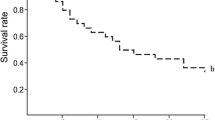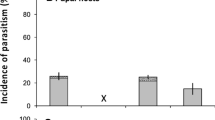Abstract
Parasitism ofCoccinella septempunctata L. byPerilitus coccinellae (Schrank) varies seasonally with an 11% overall rate among beetles overwintering in the Hackensack Meadowlands, which is less than that reported in Europe.P. coccinellae may parasitizeC. 7-punctata twice yearly. FemaleC. 7-punctata were parasitized more heavily than males. Although parasitism byP. coccinellae varied significantly among host species, it was not significantly different among 3 habitats. High host density favored greater parasitism in 3 coccinellid species. Rearing for parasite cocoons, consistently showed lower parasitism rates than did dissection for parasitized larvae. Overwintering survival of cagedC. 7-punctata near Stillwater, OK, varied between years averaging 53,5%. Infection of overwinteringC. 7-punctata byBeauveria bassiana (Balsamo) was 1,6% in 1978–1979.
Résumé
Le parasitisme deCoccinella 7-punctata L. parPerilitus coccinellae (Schrank) varie selon les saisons avec un taux maximum de 11% chez les coccinelles hivernantes dans la région de Hackensak Meadowlands, ce qui est moindre qu'en Europe.P. coccinellae peut parasiterC. 7-punctata 2 fois par an. Les femelles deC. 7-punctata sont davantage parasitées que les mâles. Le parasitisme parP. coccinellae varie de façon significative selon les espèces hôtes mais ne diffère pas dans les 3 habitats étudiés. Une forte densité en hôtes favorise le parasitisme chez 3 espèces de coccinelles. L'élevage pour obtenir les cocons des parasites donne des taux de parasitisme nettement inférieurs à ceux observés par dissection des larves parasitées. La survie pendant l'hiver en cages deC. 7-punctata, près de Stillwater, OK, est variable selon les années et en moyenne de 53,5%. L'infection parBeauveria bassiana (Balsamo) chez lesC. 7-punctata hivernantes fut de 1,6% en 1978–1979.
Similar content being viewed by others
References
Angalet, G.W. &Jacques, R.L. — 1975. The establishment ofCoccinella septempunctata L. in the continental United States. —Coop. Econ. Ins. Rep., 25, 883–884.
Angalet, G.W., Tropp, J.M. &Eggert, A.N. — 1979. Establishment ofCoccinella septempunctata L. in the United States. —Environ. Entomol., 8, 894–901.
Balduf, W.V. — 1926. The bionomics ofDinocampas coccinellae (Schrank). —Ann. Entomol. Soc. Am., 19, 465–498.
Bryden, J.W. &Bishop M.W.H. — 1945.Perilitus coccinellae (Schrank) [Hymenenoptera: Braconidae] in Cambridgeshire. —Entomol. Mon. Mag., 81, 51–52.
Cartwright, B.O., Eikenbary, R.D., Campbell, R.K. &Angalet G.W. — 1979. Release and establishment ofCoccinella septempunctata L. in Oklahoma. —Environ. Entomol., 8, 819–823.
Clayhills, T. &Markkula, M. — 1974. The abundance of coccinellids on cultivated plants. —Ann. Entomol. Fenn., 40, 49–55.
Ghorpade, K.D. — 1977. OnPerilitus coccinellae (Schrank) [Hymenoptera: Braconidae]., an endoparasite of adultCoccinellidae [Coleoptera] in Karnataka. —Mysore J. Agric. Sci., 11, 55–59.
Grizzle, J.E., Starmer, C.F. &Koch, G.G. — 1969. Analysis of categorical data by linear models. —Biometrica, 25, 489–504.
Hodek, I. — 1973. Biology ofCoccinellidae. —Dr. W. Junk, The Hague, 260 pp.
Iperti, G. — Les parasites des coccinelles aphidiphages dans les Alpes-Maritimes et les Basses-Alpes. —Entomophaga, 9, 153–180.
Lipa, J.J., Pruszynski, S. &Bartkowski, J. — 1975. The parasites and survival of the ladybrid beetles [Coccinellidae] during winter. —Acta Parasitol. Pol., 23, 453–461.
Obrycki, J.J. &Tauber, M.J. — 1979. Seasonal synchrony of the parasitePerilitus coccinellae and its hostColeomegilla maculata. —Environ. Entomol., 8, 400–405.
Parker, B.L., Whalon, M.E. &Warshaw, M. — 1977. Respiration and parasitism inColeomegilla maculata lengi [Coleoptera: Coccinellidae]. —Ann. Entomol. Soc. Am., 70, 984–987.
Richerson, J.V. &DeLoach, C.J. — 1972. Seasonal abundance ofPerilitus coccinellae and its coccinellid hosts and degree of parasitism in central Missouri.. —Environ. Entomol., 2, 138–141.
Shands, W.A., Simpson, G.W. &Storch, R.H. — 1972. Insect predators for controlling aphids on potatoes. Winter survival ofCoccinella spp. in field cages over grassland in northeastern Maine. —J. Econ. Entomol., 65, 1392–1396.
Author information
Authors and Affiliations
Additional information
Journal article number 4018 of the Oklahoma Agricultural Experiment Station. A jointly supported effort on behalf of USDA-SEA, Beneficial Insects Research Laboratory, Newark, DE and the Oklahoma Agricultural Experimental Station.
Rights and permissions
About this article
Cite this article
Cartwright, B., Eikenbary, R.D. & Angalet, G.W. Parasitism byPerilitus coccinellae [Hym.: Braconidae] of indigenous coccinellid hosts and the introducedCoccinella septempunctata [Col.: Coccinellidae], with notes on winter mortality. Entomophaga 27, 237–243 (1982). https://doi.org/10.1007/BF02374808
Issue Date:
DOI: https://doi.org/10.1007/BF02374808




